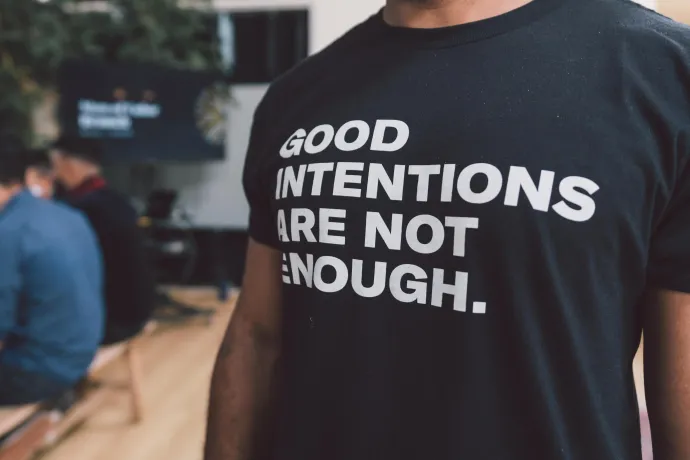The Hidden Costs of Hiding Who You Really Are
We are all a mixture of many identities. Cass A. talks about the reasons, impact, and consequences of covering (hiding) pieces of ourselves at work.
It’s morning and I’ve just arrived at the office. I walk towards the building and run into a co-worker who strikes up a conversation and wants to chat with me on our way to our desks. We enter the building. I see the flight of stairs coming. I quickly divert to take the elevator. I make up some excuse about how I recently hurt myself. Every day there is a situation where someone wants to have a conversation while walking up the stairs with me. Every day I make up an excuse to avoid them. Why? Because I'm terribly overweight and out of shape. I lose my breath and cannot hold a conversation while walking up even one flight of stairs. I consciously hide this detail about myself because I am ashamed.
This is called covering.
I consciously hide details about myself because I am ashamed.
This isn’t the only situation in which I have hidden a piece of myself due to shame, embarrassment, or stigmatization. Other examples of when I have covered:
- I have multiple invisible chronic illnesses and I don’t talk about them at work because I'm afraid of being judged, pitied, or perceived as lazy or a slacker. I worry that people may not consider me for projects or tasks because my invisible illnesses may make me appear less capable. I hide the state of my health so I won’t be treated differently.
- I have food allergies and sensitivities that require me to be very mindful of what I put into my body. When I advocate for myself people often are annoyed, make jokes at my expense, or make light of how poor food choices negatively affect my health. After attending a few all-employee events and receiving unwanted attention and addressing questions about how little (or no) food I was eating, I stopped going to events where food was offered. I cover by not talking about my needs and by avoiding going to events where I’ll have to address it.
- I have a list of canned answers to questions like “how are you doing?” or “how’s it going?” because answering them candidly some days is too complicated or too heavy. My life isn’t always easy. I conceal the true state of my life or mental health to make other people’s lives easier.
- I have often suppressed my true gender identity or sexual orientation to prevent people from trying to get me fired or blocking further career progression. I sometimes hide this core part of myself because I have experienced being kicked out of establishments, refused service or care, subjected to verbal and physical violence, and more simply because someone was uncomfortable with one of my identities. Sometimes covering is necessary for self-preservation.
Sometimes we cover to make our lives easier, to avoid conflict or questions, or to avoid shame or embarrassment. Other times we cover for personal safety reasons, to protect our sense of stability, and even to protect our very lives.
By definition, covering is the act of downplaying, minimizing, or hiding a known stigmatizing identity. According to Uncovering Talent: A New Model of Inclusion, a study by Kenji Yoshino and Christie Smith, there are four main categories where people feel the need to cover:
- Appearance: Individuals change their grooming habits, clothing style, mannerisms, and hide body modifications (e.g., tattoos & piercings) to be more palatable in the work environment.
- Affiliation: Individuals avoid talking about meaningful relationships in their lives (e.g., being a parent, being adopted, family structure/makeup, etc.) so that they are not perceived as being less committed to their work.
- Advocacy: Individuals avoid topics related to identity (e.g., veteran status, disability status, LGBTQ+ status, etc.) so they are not seen as "sticking up for" their group too stridently.
- Association: Individuals avoid being around specific types of people (e.g., lesbian, gay, bisexual, or transgender people, people of color, people of a different religions, etc.) because they want to avoid any negative stereotypes of stigmas associated with a particular group.
Covering is something that we have all done at one point or another. I'm sure you can think of a time when you’ve hidden a detail about yourself at work for the sake of fitting in or not being seen as different. Sometimes we cover to make our lives easier, to avoid conflict or questions, or to avoid shame or embarrassment. Other times we cover for personal safety reasons, to protect our sense of stability, and even to protect our very lives.
Covering essential pieces of who we are in the workplace has a detrimental effect on all of us. In fact, in an HRC study on the subject they found that the LGBTQ+ population are among the most highly affected groups by covering. What's really interesting is that the study found when people no longer have to hide and can bring their full selves to work every day, they are happier, provide better quality work, and are up to 30% more productive. If it is a company's objective to be efficient and productive then it is imperative that we address our internal culture and create a workplace environment where we all feel welcomed, valued, and respected – not just people who are “like us”, or people from backgrounds that we can relate to and understand.
The idea that we must all fit a particular mold to be successful or accepted is the antithesis of an inclusive workplace. It is the opposite of cultivating a culture of belonging.
The easiest way to combat covering in the workplace is to talk about it. Normalize it. When we recognize that it is these very details that give us a unique perspective in life, we go a long away in de-stigmatizing the very parts of ourselves that we feel the need to cover. The idea that we must all fit a particular mold to be successful or accepted is the antithesis of an inclusive workplace. It is the opposite of cultivating a culture of belonging.
To be truly inclusive we must accept our own details first – all parts of ourselves. Validate and value not only our own but also each other's individual differences. Have compassion and empathy for others with different experiences. Realize that each person has insights and perspectives that are unique and integral to the success of any given project, to the team, and to the organization. When we give ourselves permission to stop covering we inherently give other's permission to do the same.
“Your playing small does not serve the world. There is nothing enlightened about shrinking so that other people won't feel insecure around you. We are all meant to shine, as children do. And as we let our own light shine, we unconsciously give other people permission to do the same. As we are liberated from our own fear, our presence automatically liberates others.” ― Marianne Williamson








We encourage you to share your thoughts on your favorite social platform.